Star Wars Time, tra la tra la...
Editor's Note: Ok, this article is really really long, but it's also really really fascinating. (To ME, at any rate).
Building Felucia
Editor's Note: Is it just me, or does that sound not quite......it's just me?
Growing an Alien Jungle
Fans witnessing the tragic demise of Jedi Knight Aayla Secura in Revenge of the Sith also got a brief yet exciting glimpse at the colorful world of Felucia. As a world covered with fungal life-forms and immense primitive plants, the planet's humid landscape overgrown by forests of magnificent plants stood out as one of the most vibrantly colored planets of Episode III.
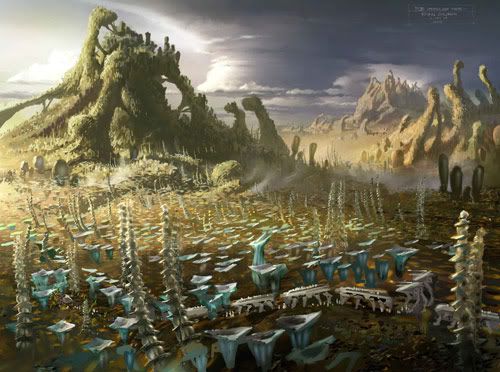
Initially filmmaker George Lucas envisioned Felucia as a "kelp planet," but after the Episode III Art Department took a crack at creating their own version of a new bizarre and lush landscape, the idea of the alien jungle took hold.
"George Lucas's early direction was that he wanted a wide variety of planets for the Clone Wars to be happening on," Concept Design Supervisor Ryan Church says. "I did a bunch of different types of planets and my idea for Felucia was one of the last I came up with. I thought it would be neat to see a planet that wasn't based on an Earth location -- one that was truly alien. I also thought it would be neat to see something without any technology -- like an alien jungle look (a lush and vibrant place but without anything really recognizable). Here was something that would really contrast with the clone armor and technology."
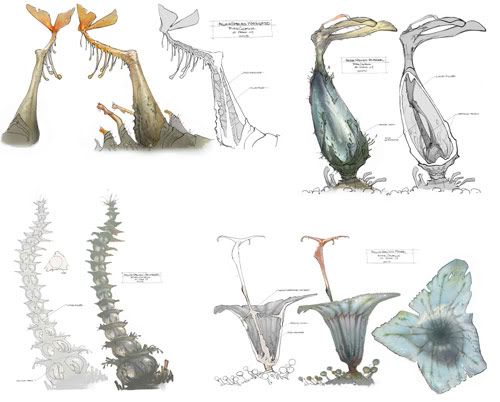
The idea of the alien jungle concept came from a mesh of ideas revolving around the latest ILM technology and of all things, a song by The Beatles. "I wanted to push the look of things into a direction not seen before, and I knew ILM was just recently able to do CG renders involving transparency. They call it 'subsurface scattering.' I wanted to push this as far as I thought possible and that was how the idea of the translucent plants came about. Believe it or not, I was also inspired by a Beatles song. A co-worker kept listening to the song 'Lucy in the Sky with Diamonds' and there's that line 'Cellophane Flowers of Yellow and Green, Towering over your Head.' This was an interesting image to me and so that's what served as the muse for my first Felucia painting, featuring giant translucent flower-plants." Editor's Note: Always nice to have new and DIFFERENT songs stuck in our heads!
When Lucas decided to move forward on the idea, all the concept artists tried their hand at coming up with the ultimate look for Felucia. While some artists concentrated on various species of animals and plants to populate the planet, others created elaborate storyboard-type illustrations to show action. "I stuck with mainly wide shots that showed what different locations could look like, the detail of the plant species, and what different lighting and atmospheric conditions could do to the look," Church says. "I also art directed the final shots down at ILM and did very detailed schematics of the plants so the ILM modelers could build them and get the look right, which was tough."
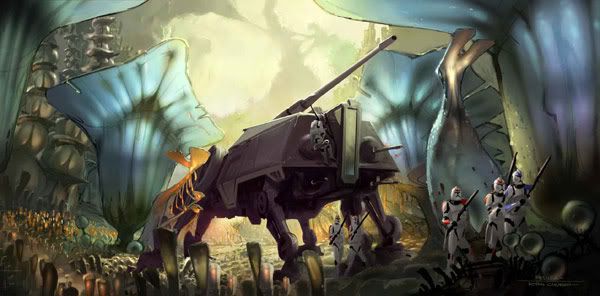
On first glance, the looming vegetation may seem like a visual tribute to exotic carnivorous plants that dwell on our own planet, however Church felt it was more important to draw inspiration from other sources from nature. "I tried to avoid the pitcher plant thing, despite the obvious superficial similarities," Church explains. "I also looked at a lot of animals like jellyfish and ctenophores. But if you look closely at the Felucia plants you will see structures that look more like fish musculature and even the texture of elephant ears. That was a problem trying to make these translucent plants look big and realistic in addition to actually supporting their own weight. Some of these plants would be 30 or 50 feet tall! I ended up figuring out a liquid-filled approach with internal supports that makes sense."
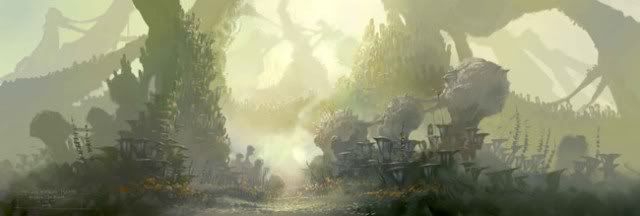
While translating the visions of Felucia from his imagination to the sketch pad, Church wanted to make sure the planet's atmosphere and landscape were not only believable, but beautiful. "I really wanted to steer clear of anything that people had seen in movies before," Church explains. "I wanted it to feel like a Vietnam War location with these high tech soldiers surrounded by a completely alien location. When you look at alien planets in almost all other movies, they are all based closely on whatever Earth location is chosen for filming. Either that or the alien planet is so dark and stormy that you can't see what's going on really. I wanted to show audiences something that might exist on another planet, not some desert or cave but a real place with an alien ecosystem and was in fact as beautiful as any forest or jungle on Earth, but completely different looking. The beauty aspect of the design was very important." Editor's Note: So the Jedi could be betrayed and murdered someplace NICE!
From Animatics to Modelmaking
As Church began to flesh out the plants even more, the concepts Lucas approved were then given to the Animatics Department to bring the planet to life. "Initially I was doing pure concept work, to show what the planet might look like and who might be there," Church says. "As Felucia was incorporated into the script and animatic I began to help George and the animatic guys think of interesting shots and scenarios to tell the story. In the end all of our work was condensed into a seven or eight-shot montage.
Animatic artist Joshua Wassung worked closely with George once he and I had built a few parts of Felucia in his computer," Church continues. "Josh would take a painting, a 2-D representation of the location, and build a set in the computer that looked like the painting but was something he could put CG actors and vehicles in and animate them into shots. Then George would sit with him and shoot a scene, for instance stage a fight between clones and droids. The next while was spent with George actually shooting the action on this virtual set -- just as any director would do on location. The process was very cool to watch. At the end of a few days George would have this little action sequence shot and edited into the larger animatic of the entire film." Editor's Note: Like playing with dolls or computer games except for big bucks?
After the animatic was complete, the model makers and other craftspeople from Industrial Light & Magic were then asked to undertake the real-life construction of Felucia's plant life. ILM Senior Model Maker Danny Wagner worked closely with a team to build the exquisite set. In addition to Wagner, the ILM crew members involved with the project included Richard Miller (sculptor), Louren Vogt and Gritsada Satjawatcharaphong (painters), and Michael Jobe (molder and caster).
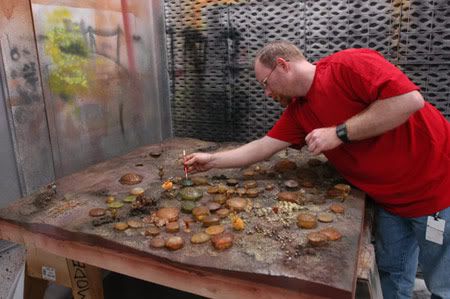
Wagner also constructed 3-D representative concept models of various other new environments for Episode III which included maquettes for the Wookiee Tree and the Command Center on Kashyyk, the Utapau sinkhole walls, grotto cave and landing platform, and the magnificent volcanoes on Mustafar.
"Felucia was actually one of the first things I did for the film at ILM," Wagner says. "I was responsible for the ground terrain sculpt and the small vegetation and plants. I also worked as stage support shooting the final miniature. It took about a month to build the set miniature with the crew and about a week shooting it."
As the model making team began to build the Felucia set, they used various ingredients from both nature and their art supply cabinets. "The dressing consists of a lot of green sphagnum moss, some finely-crushed walnut shells, different grains of sand, and ground foam," Wagner reveals. "We also used special clear crystal beads that were ideal for shiny organic matter to dress the ground." Editor's Note: Hey, OddBob! Instead of artsandcraftsy stuff that you and are making from beads, we could be making alien PLANETS!!! Oooooooo.....
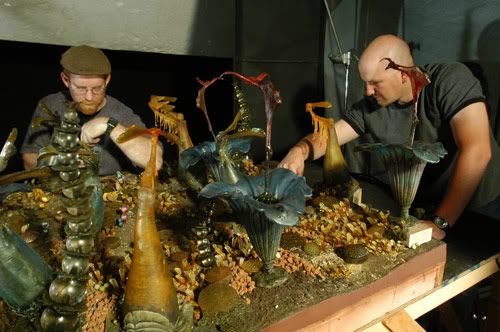
"To start things off I sculpted the ground terrain out of Y-2 clay, then sealed it with shellac and primed it," Wagner continues. "The small plants were sculpted out of Y-2 clay. I did a variety of them so ILM Visual Effects Supervisor John Knoll could pick which ones he liked. When the final choices were made, casting specialist Michael Jobe molded the parts along with the other plants. To give the various plants and flowers that special translucent glow, he used a clear urethane, WC-20, which was carefully cast in special platinum silicone mold that can only casts clear parts. Some of these molds were extremely complex. We had to make sure that the casting was clear so we could add another piece inside the plant to give it more of an inner growth look. The plant sculptures were then placed in an airtight vacuum chamber to remove any air bubbles. Some of the castings were also given a special clear urethane ink to give the plants an appearance of a soft membrane of colored tissue. Then painters and I used a combination of colors from a variety of paints such as FW inks, Tamiya clear colors, Dr. Martin watercolors and some pearl essence powders and inks. There were also a few more special craft paints we used for certain parts of the plants."
Welcome to the Jellybean Planet
The plants weren't all made from traditional materials; in fact, Wagner and the team discovered that tasty treats could easily double as vibrantly-colored plant parts. "For some parts of the plants I used a special GummiBear-type candy that was clear and orangey in color, as well as those wax cola bottle candies for one of the small leaf-like plants," Wagner says. "It was so hard to not eat all the candy before I finished the model!" Editor's Note: Yeah, working with beads is less fattening. (Although I DO sort of like fondling them......TMI?)
Keeping the plant models out of their stomachs wasn't the only obstacle the team came across during their project. "Keeping every plant clear so light could shine though and not adding too much paint to the models was a huge challenge," Wagner recalls. "You always needed to hold the plant up to the light after painting it to see if it looked good. Plus we had to always keep in mind that these models would be under stage lighting and not our fluorescent lights in the shop."
At one point during the construction process, the action figure of Aayla Secura was placed amongst the plants as a frame of reference. Wagner, who also was responsible for applying the blue makeup to actress Amy Allen who plays the Jedi Knight, was able to show the actress her character's last destination in miniature form.
"That action figure was for reference on scale at one point and a useful tool for the Director of Photography to tell the story where the lead characters are going to be during certain parts of the scene," Wagner says. "When I started to prep for Amy's makeup I had an opportunity to give a little tour of the set. Lucky the miniature was still there and I was able to show her. It was a Kodak moment: Aayla and her planet! She loved it and I'm glad she was so impressed."
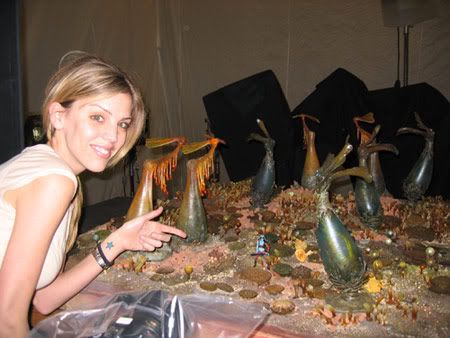
As last group to touch the Felucia sequence, ILM's digital artists had the heavy task to combine the work from the animatics team and the model makers and polish it into the final product. Working with Knoll, ILM Computer Graphics Supervisor Patrick Myers took on the shading and look development of the sequence, focusing mostly on the lighting and creature rendering elements.
"The main objective for us was to use this as an opportunity to give a new planet a unique look from the other planets we had done so far," Myers explains. "We initially wanted to have Felucia be otherworldly, and then it settled down into a cross between an underwater look and microphotography. The maquettes the model shop created had a weird, resiny kind of look to them, and we wanted to retain those characteristics."
"The process started out with us looking at the maquette work that had been done and the lighting reference they had shot for it," Myers continues. "It's always a challenge with these projects to balance what look we want to achieve with reasonable rendering times. When you get involved in creating transparent or translucent objects you can run pretty quickly into very expensive methods for doing it. That was my big concern doing it -- how can I get out my cheat book to do things and keep it looking cool, and make everyone happy with it?"
Originally when Myers and his team got hold of the raw animatic, the Felucia sequence was quite longer. "The first animatic was three times as long with three Jedi getting killed on Felucia. Then it kept getting trimmed back a little bit more and more, and so by the end instead of doing something very complicated with a lot of shots we ended up doing it a lot less shots."
Myers spent much of his time working via trial and error on the lighting of the various plants to make their translucency believable. "I did a lot of work on the whisker plant and some of the other plants as far as trying to get that kind of translucent quality that we saw in the maquettes," Myers explains. "These days you hear a lot about subsurface scattering that they use for flesh simulation and that's sort of where we started and tried that. We were already using that to show light through Yoda's ears. But then it became apparent that when we actually applied it to the plants, we were dealing with a different characteristic -- not so much with what you get with translucent silicone or marble where light hits the front surface and sort of glows around it. I kept referring to Felucia as the jellybean planet at some level because you can't necessarily see through everything but you can kind of discern the shape on the far side of objects. So we took a different page out of the rendering handbook and went for that effect. Once we started actually doing that, we were able to discern the back sides of objects through stuff, then the objects had more of a jellybean gelatinous characteristic that we were looking for." Editor's Note: Jelly Bellys! Dweeb food of the Gods!
Shedding Light on the Landscape
To keep expenses down, Myers tried various lighting tricks with the sequence. One shortcut is what digital artists refer to as "baking in" the lighting, rather than have the computer "ray trace" or calculate how each ray of light would bounce or behave. The problem with "baking," however, is that it tends to be limited only to static shots where lighting does not change from frame to frame.
"You can't necessarily 'bake' the lighting -- so we baked different angles of lighting and then blend between them to get an animated look so we could replicate hundreds of objects in a scene," Myers explains. "If we did a full-blown retrace calculation for all that stuff it would have been quite expensive."
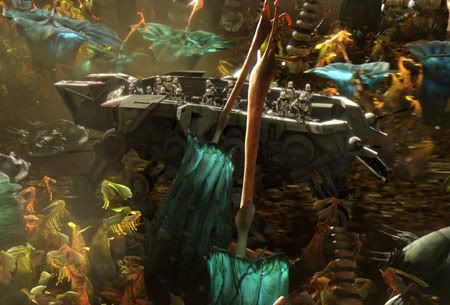
In addition to lighting, Myers also played with the movement of the plants and added floating pollen elements. "The plants were always kind of moving a little bit and that was a simulation thing," Myers says. "When we originally simulated them we had to slow everything down because they would simulate too fast and that sort of broke the scale. Also the floating pollen was a really nice touch to give you a sense that you were submerged in something, so it would look a little like you were underwater in the atmosphere."
Once the sequence was completed and edited into the final film, Myers says he still found himself happily surprised with the finish result. "The funny thing about these kinds of projects is that you spend quite a chunk of time working on them then they just rip rocket by in the actual film," Myers laughs. "But we had a chance to see how the components were working really well like the intimate shots where you're kind of down in the environment. My favorite part of the sequence was one of the shots where the walkers are going along and stepping on the plants. We were excited to explore what exactly would be inside the plants so we added a gooey syrup element -- which implied that these things would be pretty disgusting if you actually stepped on them."
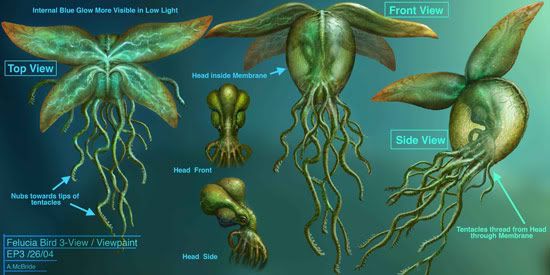
Another element that Myers had fun adding to the sequence was the flying creature that caught Aayla Secura's eye right before she was shot by the clone troopers. "Late in the development of the sequence George decided he wanted to add the equivalent of a flying bird into the sequence," Myers says. "We ended up recycling a creature from one of the other sequences -- a peko peko. We then took a Felucia glass/GummiBear shader and applied it to the bird's geometry so we would have this gelatinous flying bird thing. You're still using the same textures but with a weird translucent characteristic on top of it."
Since the fans only got a brief glimpse at Felucia's breathtakingly beautiful landscape, Myers says he would have liked to give them an even closer look at the unusual plants and their delicate structure. "I would have liked to showcase a more dynamic lighting change," Myers says. "One of the things you get to see when you're just looking at the raw elements -- the part of the scene where Aalya Securra is blasted by the clones -- we did an interactive light pass with that so you're seeing all these laser flashes go through and light up all these little weird glassy ground cover and it was really neat looking. It would have been nice to have some moment where you could see the sun behind something to really see what's going on. Because when the lighting moves you really get to see the odd resiny look of the plants."
Wagner also admits that if the planet had a larger presence in Episode III, he would have been happy to add more miniatures. "It would have been great to add even more variety of styles and shapes of the flowers and plants," Wagner smiles. "It was such a beautiful planet you can go crazy on. It's an amazing opportunity to add all shorts of interesting organic forms."
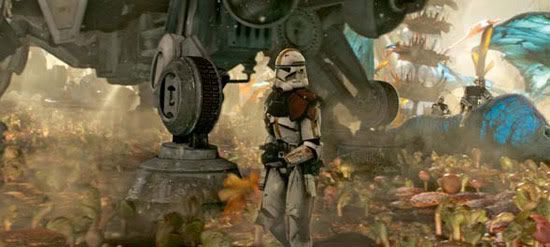
Equally enamored with the planet, Church says that he wishes that fans had the chance to explore Felucia further in Revenge of the Sith. "I actually really liked the longer sequence that George shot with Joshua," Church says. "It's basically a few scenes of clones marching through the forest, finding the enemy droid encampment, and then a battle breaks out. You also get to see more of the planet with additional wide shots and details alike. I would have enjoyed seeing what it was like for these poor clones to try and deal with that alien environment. There were also a lot of animal species designed for the planet that were never developed further that would be interesting to put in. Felucia was a favorite of mine and it was a real joy to be able to be involved with it from first sketch to seeing it on the big screen. I hope viewers like how it turned out and maybe one day they get to see some more of it!" Editor's Note: All that amazing detail and labored artistry, and those planets where the Jedi are shown being slaughtered were a blur....from my TEARS....as the reality of Order 66 hit home.
Star Wars Characters Begin Summertime Road Trip
It's a summertime tradition whose origins date back to a long time ago: the road trip.
This year, residents of a galaxy far, far away are taking part in the quintessential American experience.
From August 22 to September 11, three favorite characters from the Star Wars saga will visit 11 cities throughout the U.S.
Along for the cross-country ride: Chewbacca, Han Solo's faithful Wookiee co-pilot; Darth Vader, the Dark Lord of the Sith; and Wicket, the fierce-yet-cuddly Ewok. They'll meet fans, see sights and celebrate the simultaneous September 12 release of Star Wars, The Empire Strikes Back and Return of the Jedi on DVD, from Lucasfilm Ltd. and Twentieth Century Fox Home Entertainment, and the LEGO Star Wars II: The Original Trilogy videogame, from LucasArts and TT Games. The DVDs are available for a limited time -- only through Dec. 31.
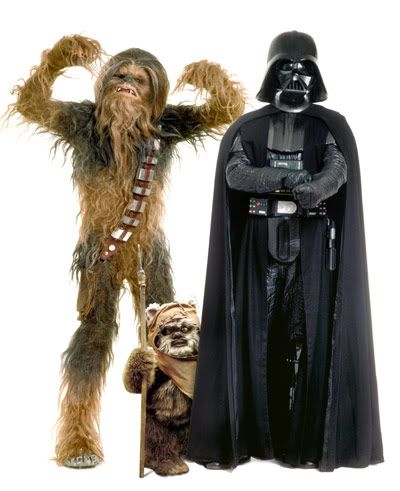
Editor's Note: Here's hoping they brought along enough snacks. Cause I'm thinkin Wicket would start to look mighty tasty mighty quick if either Chewbacca or DV get the munchies.
The journey kicks off August 22 in Miami and ends September 10 in San Diego. During the road trip, characters will visit Niagara Falls, take in some Major League and AAA baseball, attend a Las Vegas wedding and get a glimpse of the Johnson Space Center -- among a host of activities. They also will take time out to spend time with patients in children's hospitals in many of the cities.
"We receive countless letters and e-mails from people who tell us how much they love Star Wars, and we wanted to give fans a chance to meet their favorite characters and get a unique kind of Star Wars experience," said Tom Warner, Senior Director of Marketing for Lucasfilm Ltd.
Throughout the 11-city road trip, Star Wars fans will want to keep their eyes peeled and their cameras ready: By submitting their best pictures of the characters and themselves (or family members) to starwars.com, they could win a trip for four to the ultimate Star Wars event -- Celebration IV, to be held in May 2007 in Los Angeles -- or copies of the DVDs and videogame.
(Full details of the Star Wars: Bringing it Home contest and official rules, click here.)
Scheduled cities and dates* are:
Miami -- Aug. 22
Louisville -- Aug. 24
Charlotte, NC -- Aug. 25
Columbus, Ohio -- Aug. 26
Portland, Ore. -- Aug. 27
Seattle -- Aug. 28
Houston -- Sept. 3 Editor's Note: !!!! Of course I will be flying back from my parents' surprise party and going straight to REHERSAL that day, but just knowing I will be in the same CITY with the boys..........!!!!!
Kansas City -- Sept. 4
Buffalo, NY -- Sept. 6
Las Vegas -- Sept. 9
San Diego -- Sept. 11
As the road trip progresses, full plans for each city will be available here at starwars.com. Keep checking back!
* As with any summertime road trip, unanticipated events could cause changes in the schedule; keep up to date at www.starwars.com.
Editor's Note: And now, the weekly Star Wars Pictures, WOOOOHOOOO!!
Another cool 2007 Sneak Peek. And this one comes with some kind of plot/dialogue.
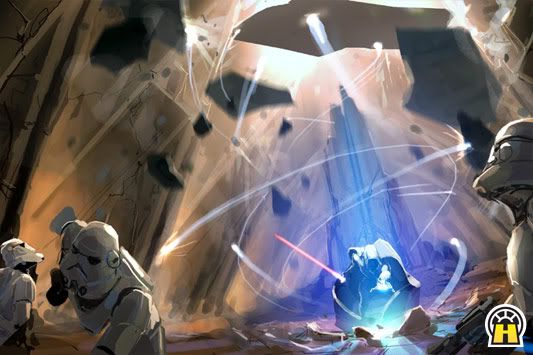
"It was a storm... there was no other word to describe it. It was like a sick joke, since we were supposed to be the stormtroopers..."
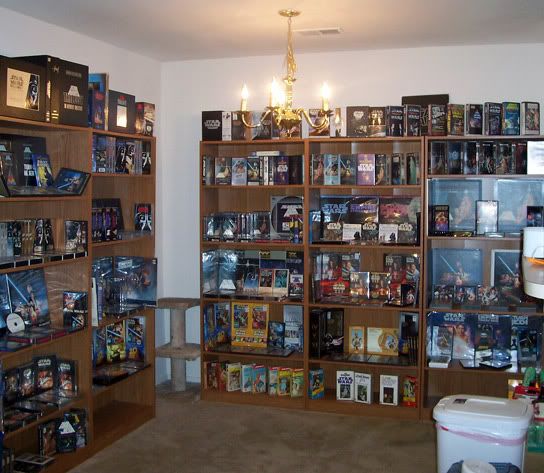
"This is every home video release of the Star Wars saga ever put out in the U.S. It even contains over 75% of those from the U.K and a fair amount from Australia and Japan." Editor's Note: I so very much want a whole room just neatly displayed with dweebing like this! (Then again, I guess the argument could be made that I have a WHOLE HOUSE full of dweebing?)
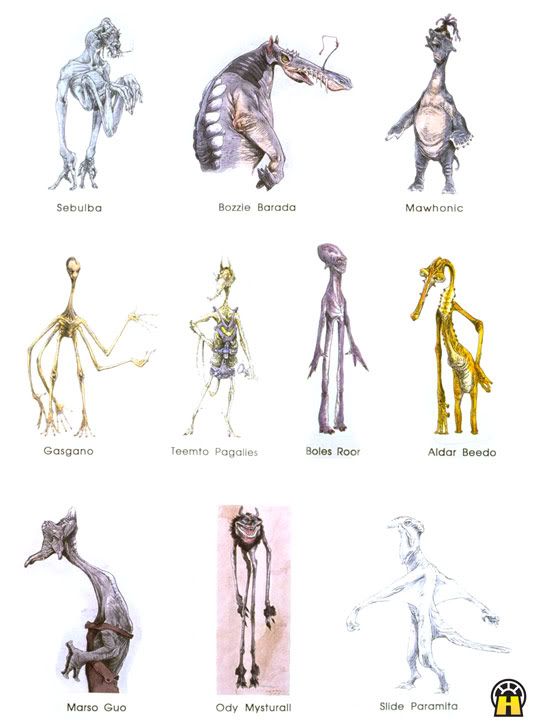
Preliminary Podracers: This early collection of Terryl Whitlatch Podracer pilot art reveals changes in names and design; Dud Bolt here is named Bozzie Baranta, Ody Mandrell is named Boles Roor, Mawhonic and Teemto Pagalies look quite different, and Ody Mysturall and Slide Paramita would not make it to the finished film.

Read or I'll shoot you?
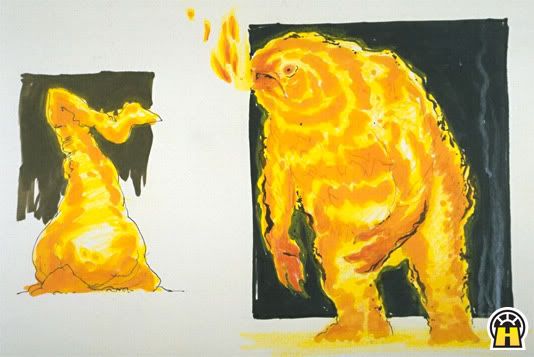
Hot Stuff: This unattributed illustration for Return of the Jedi features magma creatures to possibly inhabit the fiery lair of the Emperor, as originally envisioned in the early draft scripts for the movie.
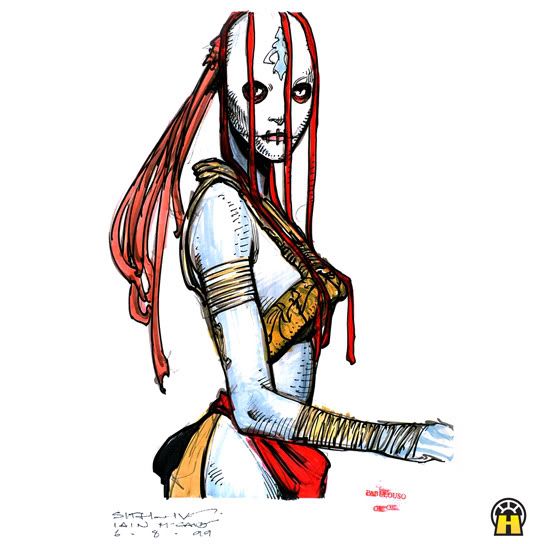
Dark Lady of the Sith: Iain McCaig's creepy illustration of a female Sith Lord developed yet ultimately abandoned for Episode II. Editor's Note: I think I have found myself a new (and yet still unattainable) diet goal. Next Halloween's costume, dweebpals? (Slave Leia was getting old, eh?)
Building Felucia
Editor's Note: Is it just me, or does that sound not quite......it's just me?
Growing an Alien Jungle
Fans witnessing the tragic demise of Jedi Knight Aayla Secura in Revenge of the Sith also got a brief yet exciting glimpse at the colorful world of Felucia. As a world covered with fungal life-forms and immense primitive plants, the planet's humid landscape overgrown by forests of magnificent plants stood out as one of the most vibrantly colored planets of Episode III.

Initially filmmaker George Lucas envisioned Felucia as a "kelp planet," but after the Episode III Art Department took a crack at creating their own version of a new bizarre and lush landscape, the idea of the alien jungle took hold.
"George Lucas's early direction was that he wanted a wide variety of planets for the Clone Wars to be happening on," Concept Design Supervisor Ryan Church says. "I did a bunch of different types of planets and my idea for Felucia was one of the last I came up with. I thought it would be neat to see a planet that wasn't based on an Earth location -- one that was truly alien. I also thought it would be neat to see something without any technology -- like an alien jungle look (a lush and vibrant place but without anything really recognizable). Here was something that would really contrast with the clone armor and technology."

The idea of the alien jungle concept came from a mesh of ideas revolving around the latest ILM technology and of all things, a song by The Beatles. "I wanted to push the look of things into a direction not seen before, and I knew ILM was just recently able to do CG renders involving transparency. They call it 'subsurface scattering.' I wanted to push this as far as I thought possible and that was how the idea of the translucent plants came about. Believe it or not, I was also inspired by a Beatles song. A co-worker kept listening to the song 'Lucy in the Sky with Diamonds' and there's that line 'Cellophane Flowers of Yellow and Green, Towering over your Head.' This was an interesting image to me and so that's what served as the muse for my first Felucia painting, featuring giant translucent flower-plants." Editor's Note: Always nice to have new and DIFFERENT songs stuck in our heads!
When Lucas decided to move forward on the idea, all the concept artists tried their hand at coming up with the ultimate look for Felucia. While some artists concentrated on various species of animals and plants to populate the planet, others created elaborate storyboard-type illustrations to show action. "I stuck with mainly wide shots that showed what different locations could look like, the detail of the plant species, and what different lighting and atmospheric conditions could do to the look," Church says. "I also art directed the final shots down at ILM and did very detailed schematics of the plants so the ILM modelers could build them and get the look right, which was tough."

On first glance, the looming vegetation may seem like a visual tribute to exotic carnivorous plants that dwell on our own planet, however Church felt it was more important to draw inspiration from other sources from nature. "I tried to avoid the pitcher plant thing, despite the obvious superficial similarities," Church explains. "I also looked at a lot of animals like jellyfish and ctenophores. But if you look closely at the Felucia plants you will see structures that look more like fish musculature and even the texture of elephant ears. That was a problem trying to make these translucent plants look big and realistic in addition to actually supporting their own weight. Some of these plants would be 30 or 50 feet tall! I ended up figuring out a liquid-filled approach with internal supports that makes sense."

While translating the visions of Felucia from his imagination to the sketch pad, Church wanted to make sure the planet's atmosphere and landscape were not only believable, but beautiful. "I really wanted to steer clear of anything that people had seen in movies before," Church explains. "I wanted it to feel like a Vietnam War location with these high tech soldiers surrounded by a completely alien location. When you look at alien planets in almost all other movies, they are all based closely on whatever Earth location is chosen for filming. Either that or the alien planet is so dark and stormy that you can't see what's going on really. I wanted to show audiences something that might exist on another planet, not some desert or cave but a real place with an alien ecosystem and was in fact as beautiful as any forest or jungle on Earth, but completely different looking. The beauty aspect of the design was very important." Editor's Note: So the Jedi could be betrayed and murdered someplace NICE!
From Animatics to Modelmaking
As Church began to flesh out the plants even more, the concepts Lucas approved were then given to the Animatics Department to bring the planet to life. "Initially I was doing pure concept work, to show what the planet might look like and who might be there," Church says. "As Felucia was incorporated into the script and animatic I began to help George and the animatic guys think of interesting shots and scenarios to tell the story. In the end all of our work was condensed into a seven or eight-shot montage.
Animatic artist Joshua Wassung worked closely with George once he and I had built a few parts of Felucia in his computer," Church continues. "Josh would take a painting, a 2-D representation of the location, and build a set in the computer that looked like the painting but was something he could put CG actors and vehicles in and animate them into shots. Then George would sit with him and shoot a scene, for instance stage a fight between clones and droids. The next while was spent with George actually shooting the action on this virtual set -- just as any director would do on location. The process was very cool to watch. At the end of a few days George would have this little action sequence shot and edited into the larger animatic of the entire film." Editor's Note: Like playing with dolls or computer games except for big bucks?
After the animatic was complete, the model makers and other craftspeople from Industrial Light & Magic were then asked to undertake the real-life construction of Felucia's plant life. ILM Senior Model Maker Danny Wagner worked closely with a team to build the exquisite set. In addition to Wagner, the ILM crew members involved with the project included Richard Miller (sculptor), Louren Vogt and Gritsada Satjawatcharaphong (painters), and Michael Jobe (molder and caster).

Wagner also constructed 3-D representative concept models of various other new environments for Episode III which included maquettes for the Wookiee Tree and the Command Center on Kashyyk, the Utapau sinkhole walls, grotto cave and landing platform, and the magnificent volcanoes on Mustafar.
"Felucia was actually one of the first things I did for the film at ILM," Wagner says. "I was responsible for the ground terrain sculpt and the small vegetation and plants. I also worked as stage support shooting the final miniature. It took about a month to build the set miniature with the crew and about a week shooting it."
As the model making team began to build the Felucia set, they used various ingredients from both nature and their art supply cabinets. "The dressing consists of a lot of green sphagnum moss, some finely-crushed walnut shells, different grains of sand, and ground foam," Wagner reveals. "We also used special clear crystal beads that were ideal for shiny organic matter to dress the ground." Editor's Note: Hey, OddBob! Instead of artsandcraftsy stuff that you and are making from beads, we could be making alien PLANETS!!! Oooooooo.....

"To start things off I sculpted the ground terrain out of Y-2 clay, then sealed it with shellac and primed it," Wagner continues. "The small plants were sculpted out of Y-2 clay. I did a variety of them so ILM Visual Effects Supervisor John Knoll could pick which ones he liked. When the final choices were made, casting specialist Michael Jobe molded the parts along with the other plants. To give the various plants and flowers that special translucent glow, he used a clear urethane, WC-20, which was carefully cast in special platinum silicone mold that can only casts clear parts. Some of these molds were extremely complex. We had to make sure that the casting was clear so we could add another piece inside the plant to give it more of an inner growth look. The plant sculptures were then placed in an airtight vacuum chamber to remove any air bubbles. Some of the castings were also given a special clear urethane ink to give the plants an appearance of a soft membrane of colored tissue. Then painters and I used a combination of colors from a variety of paints such as FW inks, Tamiya clear colors, Dr. Martin watercolors and some pearl essence powders and inks. There were also a few more special craft paints we used for certain parts of the plants."
Welcome to the Jellybean Planet
The plants weren't all made from traditional materials; in fact, Wagner and the team discovered that tasty treats could easily double as vibrantly-colored plant parts. "For some parts of the plants I used a special GummiBear-type candy that was clear and orangey in color, as well as those wax cola bottle candies for one of the small leaf-like plants," Wagner says. "It was so hard to not eat all the candy before I finished the model!" Editor's Note: Yeah, working with beads is less fattening. (Although I DO sort of like fondling them......TMI?)
Keeping the plant models out of their stomachs wasn't the only obstacle the team came across during their project. "Keeping every plant clear so light could shine though and not adding too much paint to the models was a huge challenge," Wagner recalls. "You always needed to hold the plant up to the light after painting it to see if it looked good. Plus we had to always keep in mind that these models would be under stage lighting and not our fluorescent lights in the shop."
At one point during the construction process, the action figure of Aayla Secura was placed amongst the plants as a frame of reference. Wagner, who also was responsible for applying the blue makeup to actress Amy Allen who plays the Jedi Knight, was able to show the actress her character's last destination in miniature form.
"That action figure was for reference on scale at one point and a useful tool for the Director of Photography to tell the story where the lead characters are going to be during certain parts of the scene," Wagner says. "When I started to prep for Amy's makeup I had an opportunity to give a little tour of the set. Lucky the miniature was still there and I was able to show her. It was a Kodak moment: Aayla and her planet! She loved it and I'm glad she was so impressed."

As last group to touch the Felucia sequence, ILM's digital artists had the heavy task to combine the work from the animatics team and the model makers and polish it into the final product. Working with Knoll, ILM Computer Graphics Supervisor Patrick Myers took on the shading and look development of the sequence, focusing mostly on the lighting and creature rendering elements.
"The main objective for us was to use this as an opportunity to give a new planet a unique look from the other planets we had done so far," Myers explains. "We initially wanted to have Felucia be otherworldly, and then it settled down into a cross between an underwater look and microphotography. The maquettes the model shop created had a weird, resiny kind of look to them, and we wanted to retain those characteristics."
"The process started out with us looking at the maquette work that had been done and the lighting reference they had shot for it," Myers continues. "It's always a challenge with these projects to balance what look we want to achieve with reasonable rendering times. When you get involved in creating transparent or translucent objects you can run pretty quickly into very expensive methods for doing it. That was my big concern doing it -- how can I get out my cheat book to do things and keep it looking cool, and make everyone happy with it?"
Originally when Myers and his team got hold of the raw animatic, the Felucia sequence was quite longer. "The first animatic was three times as long with three Jedi getting killed on Felucia. Then it kept getting trimmed back a little bit more and more, and so by the end instead of doing something very complicated with a lot of shots we ended up doing it a lot less shots."
Myers spent much of his time working via trial and error on the lighting of the various plants to make their translucency believable. "I did a lot of work on the whisker plant and some of the other plants as far as trying to get that kind of translucent quality that we saw in the maquettes," Myers explains. "These days you hear a lot about subsurface scattering that they use for flesh simulation and that's sort of where we started and tried that. We were already using that to show light through Yoda's ears. But then it became apparent that when we actually applied it to the plants, we were dealing with a different characteristic -- not so much with what you get with translucent silicone or marble where light hits the front surface and sort of glows around it. I kept referring to Felucia as the jellybean planet at some level because you can't necessarily see through everything but you can kind of discern the shape on the far side of objects. So we took a different page out of the rendering handbook and went for that effect. Once we started actually doing that, we were able to discern the back sides of objects through stuff, then the objects had more of a jellybean gelatinous characteristic that we were looking for." Editor's Note: Jelly Bellys! Dweeb food of the Gods!
Shedding Light on the Landscape
To keep expenses down, Myers tried various lighting tricks with the sequence. One shortcut is what digital artists refer to as "baking in" the lighting, rather than have the computer "ray trace" or calculate how each ray of light would bounce or behave. The problem with "baking," however, is that it tends to be limited only to static shots where lighting does not change from frame to frame.
"You can't necessarily 'bake' the lighting -- so we baked different angles of lighting and then blend between them to get an animated look so we could replicate hundreds of objects in a scene," Myers explains. "If we did a full-blown retrace calculation for all that stuff it would have been quite expensive."

In addition to lighting, Myers also played with the movement of the plants and added floating pollen elements. "The plants were always kind of moving a little bit and that was a simulation thing," Myers says. "When we originally simulated them we had to slow everything down because they would simulate too fast and that sort of broke the scale. Also the floating pollen was a really nice touch to give you a sense that you were submerged in something, so it would look a little like you were underwater in the atmosphere."
Once the sequence was completed and edited into the final film, Myers says he still found himself happily surprised with the finish result. "The funny thing about these kinds of projects is that you spend quite a chunk of time working on them then they just rip rocket by in the actual film," Myers laughs. "But we had a chance to see how the components were working really well like the intimate shots where you're kind of down in the environment. My favorite part of the sequence was one of the shots where the walkers are going along and stepping on the plants. We were excited to explore what exactly would be inside the plants so we added a gooey syrup element -- which implied that these things would be pretty disgusting if you actually stepped on them."

Another element that Myers had fun adding to the sequence was the flying creature that caught Aayla Secura's eye right before she was shot by the clone troopers. "Late in the development of the sequence George decided he wanted to add the equivalent of a flying bird into the sequence," Myers says. "We ended up recycling a creature from one of the other sequences -- a peko peko. We then took a Felucia glass/GummiBear shader and applied it to the bird's geometry so we would have this gelatinous flying bird thing. You're still using the same textures but with a weird translucent characteristic on top of it."
Since the fans only got a brief glimpse at Felucia's breathtakingly beautiful landscape, Myers says he would have liked to give them an even closer look at the unusual plants and their delicate structure. "I would have liked to showcase a more dynamic lighting change," Myers says. "One of the things you get to see when you're just looking at the raw elements -- the part of the scene where Aalya Securra is blasted by the clones -- we did an interactive light pass with that so you're seeing all these laser flashes go through and light up all these little weird glassy ground cover and it was really neat looking. It would have been nice to have some moment where you could see the sun behind something to really see what's going on. Because when the lighting moves you really get to see the odd resiny look of the plants."
Wagner also admits that if the planet had a larger presence in Episode III, he would have been happy to add more miniatures. "It would have been great to add even more variety of styles and shapes of the flowers and plants," Wagner smiles. "It was such a beautiful planet you can go crazy on. It's an amazing opportunity to add all shorts of interesting organic forms."

Equally enamored with the planet, Church says that he wishes that fans had the chance to explore Felucia further in Revenge of the Sith. "I actually really liked the longer sequence that George shot with Joshua," Church says. "It's basically a few scenes of clones marching through the forest, finding the enemy droid encampment, and then a battle breaks out. You also get to see more of the planet with additional wide shots and details alike. I would have enjoyed seeing what it was like for these poor clones to try and deal with that alien environment. There were also a lot of animal species designed for the planet that were never developed further that would be interesting to put in. Felucia was a favorite of mine and it was a real joy to be able to be involved with it from first sketch to seeing it on the big screen. I hope viewers like how it turned out and maybe one day they get to see some more of it!" Editor's Note: All that amazing detail and labored artistry, and those planets where the Jedi are shown being slaughtered were a blur....from my TEARS....as the reality of Order 66 hit home.
Star Wars Characters Begin Summertime Road Trip
It's a summertime tradition whose origins date back to a long time ago: the road trip.
This year, residents of a galaxy far, far away are taking part in the quintessential American experience.
From August 22 to September 11, three favorite characters from the Star Wars saga will visit 11 cities throughout the U.S.
Along for the cross-country ride: Chewbacca, Han Solo's faithful Wookiee co-pilot; Darth Vader, the Dark Lord of the Sith; and Wicket, the fierce-yet-cuddly Ewok. They'll meet fans, see sights and celebrate the simultaneous September 12 release of Star Wars, The Empire Strikes Back and Return of the Jedi on DVD, from Lucasfilm Ltd. and Twentieth Century Fox Home Entertainment, and the LEGO Star Wars II: The Original Trilogy videogame, from LucasArts and TT Games. The DVDs are available for a limited time -- only through Dec. 31.

Editor's Note: Here's hoping they brought along enough snacks. Cause I'm thinkin Wicket would start to look mighty tasty mighty quick if either Chewbacca or DV get the munchies.
The journey kicks off August 22 in Miami and ends September 10 in San Diego. During the road trip, characters will visit Niagara Falls, take in some Major League and AAA baseball, attend a Las Vegas wedding and get a glimpse of the Johnson Space Center -- among a host of activities. They also will take time out to spend time with patients in children's hospitals in many of the cities.
"We receive countless letters and e-mails from people who tell us how much they love Star Wars, and we wanted to give fans a chance to meet their favorite characters and get a unique kind of Star Wars experience," said Tom Warner, Senior Director of Marketing for Lucasfilm Ltd.
Throughout the 11-city road trip, Star Wars fans will want to keep their eyes peeled and their cameras ready: By submitting their best pictures of the characters and themselves (or family members) to starwars.com, they could win a trip for four to the ultimate Star Wars event -- Celebration IV, to be held in May 2007 in Los Angeles -- or copies of the DVDs and videogame.
(Full details of the Star Wars: Bringing it Home contest and official rules, click here.)
Scheduled cities and dates* are:
Miami -- Aug. 22
Louisville -- Aug. 24
Charlotte, NC -- Aug. 25
Columbus, Ohio -- Aug. 26
Portland, Ore. -- Aug. 27
Seattle -- Aug. 28
Houston -- Sept. 3 Editor's Note: !!!! Of course I will be flying back from my parents' surprise party and going straight to REHERSAL that day, but just knowing I will be in the same CITY with the boys..........!!!!!
Kansas City -- Sept. 4
Buffalo, NY -- Sept. 6
Las Vegas -- Sept. 9
San Diego -- Sept. 11
As the road trip progresses, full plans for each city will be available here at starwars.com. Keep checking back!
* As with any summertime road trip, unanticipated events could cause changes in the schedule; keep up to date at www.starwars.com.
Editor's Note: And now, the weekly Star Wars Pictures, WOOOOHOOOO!!
Another cool 2007 Sneak Peek. And this one comes with some kind of plot/dialogue.

"It was a storm... there was no other word to describe it. It was like a sick joke, since we were supposed to be the stormtroopers..."

"This is every home video release of the Star Wars saga ever put out in the U.S. It even contains over 75% of those from the U.K and a fair amount from Australia and Japan." Editor's Note: I so very much want a whole room just neatly displayed with dweebing like this! (Then again, I guess the argument could be made that I have a WHOLE HOUSE full of dweebing?)

Preliminary Podracers: This early collection of Terryl Whitlatch Podracer pilot art reveals changes in names and design; Dud Bolt here is named Bozzie Baranta, Ody Mandrell is named Boles Roor, Mawhonic and Teemto Pagalies look quite different, and Ody Mysturall and Slide Paramita would not make it to the finished film.

Read or I'll shoot you?

Hot Stuff: This unattributed illustration for Return of the Jedi features magma creatures to possibly inhabit the fiery lair of the Emperor, as originally envisioned in the early draft scripts for the movie.

Dark Lady of the Sith: Iain McCaig's creepy illustration of a female Sith Lord developed yet ultimately abandoned for Episode II. Editor's Note: I think I have found myself a new (and yet still unattainable) diet goal. Next Halloween's costume, dweebpals? (Slave Leia was getting old, eh?)


1 Comments:
Good reading this ppost
Post a Comment
<< Home